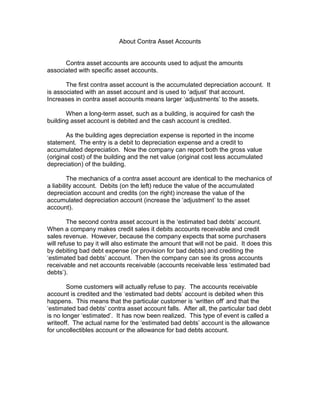
Contra asset
- 1. About Contra Asset Accounts Contra asset accounts are accounts used to adjust the amounts associated with specific asset accounts. The first contra asset account is the accumulated depreciation account. It is associated with an asset account and is used to ‘adjust’ that account. Increases in contra asset accounts means larger ‘adjustments’ to the assets. When a long-term asset, such as a building, is acquired for cash the building asset account is debited and the cash account is credited. As the building ages depreciation expense is reported in the income statement. The entry is a debit to depreciation expense and a credit to accumulated depreciation. Now the company can report both the gross value (original cost) of the building and the net value (original cost less accumulated depreciation) of the building. The mechanics of a contra asset account are identical to the mechanics of a liability account. Debits (on the left) reduce the value of the accumulated depreciation account and credits (on the right) increase the value of the accumulated depreciation account (increase the ‘adjustment’ to the asset account). The second contra asset account is the ‘estimated bad debts’ account. When a company makes credit sales it debits accounts receivable and credit sales revenue. However, because the company expects that some purchasers will refuse to pay it will also estimate the amount that will not be paid. It does this by debiting bad debt expense (or provision for bad debts) and crediting the ‘estimated bad debts’ account. Then the company can see its gross accounts receivable and net accounts receivable (accounts receivable less ‘estimated bad debts’). Some customers will actually refuse to pay. The accounts receivable account is credited and the ‘estimated bad debts’ account is debited when this happens. This means that the particular customer is ‘written off’ and that the ‘estimated bad debts’ contra asset account falls. After all, the particular bad debt is no longer ‘estimated’. It has now been realized. This type of event is called a writeoff. The actual name for the ‘estimated bad debts’ account is the allowance for uncollectibles account or the allowance for bad debts account.
